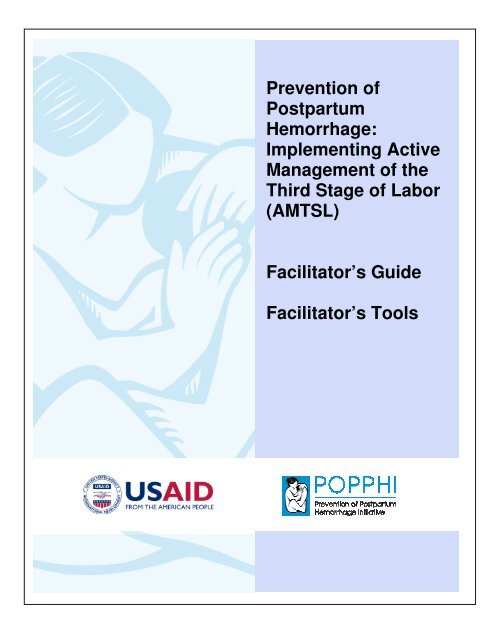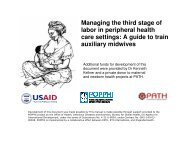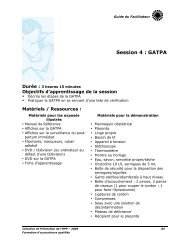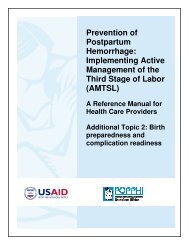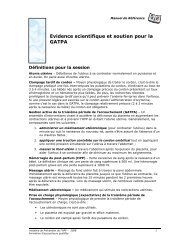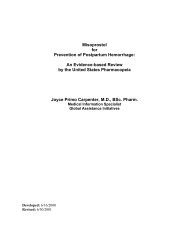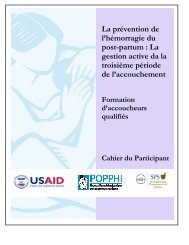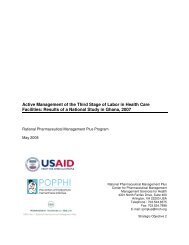Prevention of Postpartum Hemorrhage: Implementing ... - POPPHI
Prevention of Postpartum Hemorrhage: Implementing ... - POPPHI
Prevention of Postpartum Hemorrhage: Implementing ... - POPPHI
You also want an ePaper? Increase the reach of your titles
YUMPU automatically turns print PDFs into web optimized ePapers that Google loves.
<strong>Prevention</strong> <strong>of</strong><strong>Postpartum</strong><strong>Hemorrhage</strong>:<strong>Implementing</strong> ActiveManagement <strong>of</strong> theThird Stage <strong>of</strong> Labor(AMTSL)Facilitator’s GuideFacilitator’s Tools
Table <strong>of</strong> contentsChecklists for Facilitators ................................................................................ 3Checklist for Classroom Presentation Skills .............................................................3Checklist for Clinical Coaching Skills.......................................................................4Checklist for Clinical Demonstration Skills...............................................................6Administrative Documents .............................................................................. 7Registration Form ................................................................................................7Pre-Course Questionnaire: AMTSL .......................................................................11KEY Pre-Course Questionnaire: AMTSL .................................................................13Mid-Course Questionnaire: AMTSL .......................................................................15KEY Mid-Course Questionnaire: AMTSL.................................................................19Alternate Mid-Course Questionnaire: AMTSL .........................................................23KEY Alternate Mid-Course Questionnaire: AMTSL ...................................................27Facilitator’s Tools ......................................................................................... 31Training report form ..........................................................................................31Documents, Forms, and Equipment Needed for 3-Day AMTSL Training .....................33Facilitator responsibility list.................................................................................35Text References........................................................................................... 38ii<strong>Prevention</strong> <strong>of</strong> <strong>Postpartum</strong> <strong>Hemorrhage</strong>: <strong>Implementing</strong> Active Management <strong>of</strong> the Third Stage <strong>of</strong> Labor
Facilitator’s GuideChecklists for FacilitatorsThe following checklists* can be used by facilitators to assess their own clinicalteaching skills or to provide feedback to other facilitators.Checklist for Classroom Presentation Skills(To be completed by Facilitator)Place a in case box if step/task is performed satisfactorily, an ”X” if it isnot performed satisfactorily, or N/O if not observed.Satisfactory: Performs the step or task according to standard procedure orguidelines.Unsatisfactory: Does not perform the step or task according to standardprocedure or guidelines.Not Observed: Step or task not performed by participant during evaluationby facilitator.Checklist for Classroom Presentation SkillsSTEP/TASK1. Presents an effective introduction.2. States the objective(s) as part <strong>of</strong> the introduction.3. Asks questions <strong>of</strong> the entire group.4. Targets questions to individuals.5. Asks questions at a variety <strong>of</strong> levels.6. Uses participant names.7. Provides positive feedback.8. Responds to participant questions.9. Follows facilitator's notes and/or a personalized referencemanual.10. Maintains eye contact.11. Projects voice so that all participants can hear.12. Moves about the room.13. Uses audiovisuals effectively.14. Displays a positive use <strong>of</strong> humor.15. Presents an effective summary.16. Provides for application or practice <strong>of</strong> presentationcontent.Delivered an effective classroom presentation* Checklists from www.reproline.jhu.edu, the website <strong>of</strong> the JHPIEGO Corporation. 7OBSERVATIONS<strong>Prevention</strong> <strong>of</strong> <strong>Postpartum</strong> <strong>Hemorrhage</strong>: <strong>Implementing</strong> Active Management <strong>of</strong> the Third Stage <strong>of</strong> Labor 3
Checklist for Clinical Coaching Skills 7(To be completed by Facilitator)Place a in case box if step/task is performed satisfactorily, an ”X” if it isnot performed satisfactorily, or N/O if not observed.Satisfactory: Performs the step or task according to standard procedure orguidelines.Unsatisfactory: Does not perform the step or task according to standardprocedure or guidelines.Not Observed: Step or task not performed by facilitator during evaluationby a peer facilitator.Before practice session1. Greets participant.Checklist for Clinical Coaching SkillsSTEP/TASK2. Asks the participant to review her/his performancein previous practice sessions.3. Asks the participant which steps or tasks s/he wouldlike to work on during the practice session.4. Reviews any difficult steps or tasks in the checklistthat will be practiced during the session.5. Works with the participant to set specific goals forthe practice session.During practice session1. Observes the participant as s/he practices theprocedure.2. Provides positive reinforcement and suggestions forimprovement as the participant practices theprocedure.3. Refers to the checklist during observation.4. Records notes about participant performance on thechecklist during the observation.5. Is sensitive to the client when providing feedback tothe participant during a clinical session with clients.6. Provides corrective comments only when thecomfort or safety <strong>of</strong> the client is in doubt.OBSERVATIONS4 <strong>Prevention</strong> <strong>of</strong> <strong>Postpartum</strong> <strong>Hemorrhage</strong>: <strong>Implementing</strong> Active Management <strong>of</strong> the Third Stage <strong>of</strong> Labor
Facilitator’s GuideChecklist for Clinical Coaching SkillsSTEP/TASKAfter practice feedback session1. Greets the participant.2. Asks the participant to share feelings about thepractice session.3. Asks the participant to identify those stepsperformed well.4. Asks the participant to identify those steps whereperformance could be improved.5. Refers to notes on the learning guide.6. Provides positive reinforcement regarding thosesteps or tasks the participant performed well.7. Offers specific suggestions for improvement.8. Works with the participant to establish goals for thenext practice session.Used effective coaching skillsOBSERVATIONS<strong>Prevention</strong> <strong>of</strong> <strong>Postpartum</strong> <strong>Hemorrhage</strong>: <strong>Implementing</strong> Active Management <strong>of</strong> the Third Stage <strong>of</strong> Labor 5
Checklist for Clinical Demonstration Skills(To be completed by Facilitator)Place a in case box if step/task is performed satisfactorily, an ”X” if it isnot performed satisfactorily, or N/O if not observed.Satisfactory: Performs the step or task according to standard procedure orguidelines.Unsatisfactory: Does not perform the step or task according to standardprocedure or guidelines.Not Observed: Step or task not performed by facilitator during evaluationby a peer facilitator.Checklist for Clinical Demonstration SkillsSTEP/TASK1. Uses facilitator's notes or a personalized referencemanual.2. States the objective(s) as part <strong>of</strong> the introduction.3. Presents an effective introduction.4. Arranges demonstration area so that participantsare able to see each step in the procedure clearly.5. Never demonstrates an incorrect procedure orshortcut.6. Communicates with the model or client duringdemonstration <strong>of</strong> the skill/activity.7. Asks questions and encourages participants to askquestions.8. Demonstrates or simulates appropriate infectionprevention practices.9. When using model, positions model as an actualclient.10. Maintains eye contact with participants as much aspossible.11. Projects voice so that all participants can hear.12. Provides participants opportunities to practice theskill/activity under direct supervision.Presented an effective clinical demonstrationOBSERVATIONS6 <strong>Prevention</strong> <strong>of</strong> <strong>Postpartum</strong> <strong>Hemorrhage</strong>: <strong>Implementing</strong> Active Management <strong>of</strong> the Third Stage <strong>of</strong> Labor
Facilitator’s GuideAdministrative Documents<strong>POPPHI</strong>: ACTIVE MANAGEMENT OF THETHIRD STAGE OF LABOR TRAINING PROGRAMRegistration FormGeneral InformationName______________________________________________________Surname First MiddleTitle: Mrs. ( ) Miss ( ) Ms. ( ) Mr. ( ) Dr. ( )Sex: Male____ Female_____Contact Address ___________________________________________________________________________________________________________Home or mobile telephone_______________ E-mail________________Place <strong>of</strong> work ________________________________________________Address____________________________________________________Telephone__________________Work E-mail__________________Pr<strong>of</strong>essional QualificationPlease tick all that applyRegistered Nurse____Registered Midwife____ Public Health Nurse____Obstetrical Nurse ____Obstetrician/Gynecologist____ Physician____ Clinical Officer______Medical Assistant____Other (please specify) _________________________________________<strong>Prevention</strong> <strong>of</strong> <strong>Postpartum</strong> <strong>Hemorrhage</strong>: <strong>Implementing</strong> Active Management <strong>of</strong> the Third Stage <strong>of</strong> Labor 7
AMTSL Training Registration Form- Page 2 -Job Title/Designation ______________________________________Position _____________________Primary ResponsibilityClinical teaching___________Clinical practice________Administration_________Other (please specify) ___________________________________________Main area <strong>of</strong> clinical work or teaching (tick the area where youspend most <strong>of</strong> your time as a provider or tutor/facilitator)Antenatal clinic___________Labor ward________<strong>Postpartum</strong> ward_______Family planning clinic_________Other (please specify) _______________________Number <strong>of</strong> births you have attended in the last 3 months:None ( ) 0-10 births ( ) 11-20 births ( ) >20 births ( )Experience with active management <strong>of</strong> third stage <strong>of</strong> labor (AMTSL)Previous training in AMTSL: Yes ( ) No ( )If yes: Date <strong>of</strong> training in AMTSL: ______/______ (mm/yyyy)Organization that provided training in AMTSL:Pre-Service Education ( ) MOH ( ) NGO ( ) UNICEF ( )UNFPA ( ) Other (please specify) _____________ ( )Number <strong>of</strong> times you have practiced AMTSL: Never practiced ( )0-10 times ( ) 11-20 times ( ) >20 times ( )8 <strong>Prevention</strong> <strong>of</strong> <strong>Postpartum</strong> <strong>Hemorrhage</strong>: <strong>Implementing</strong> Active Management <strong>of</strong> the Third Stage <strong>of</strong> Labor
Facilitator’s GuideFinal Evaluation FormPlease evaluate the following by ticking (̌) how you feel about each statement.Feel free to comment below and use the back for more writing space.Statement1. For the work I do, trainingwas appropriate.2. For the work I do, trainingwas helpful.3. Training facilities andarrangements weresatisfactory.4. The Participant’s Manual andother reading materials wereeasy to understand.5. The reference manual andother reading materialshelped me to learn.6. Teaching aids were useful(films, charts, models).7. The methods used forteaching were helpful (casestudies, role-plays, clinical).8. The facilitators wereknowledgeable and skilled.9. The facilitators were fair andfriendly.10. The facilitatorscommunicated clearly andsimply.11. The objectives <strong>of</strong> the trainingwere met.StronglyAgreeAgreeNotDecidedDisagreeStronglyDisagree12. What 3 topics were most useful to you?13. What 3 topics were not useful to you?14. What 3 things would you change about the training?Other comments (please use back <strong>of</strong> paper if needed):<strong>Prevention</strong> <strong>of</strong> <strong>Postpartum</strong> <strong>Hemorrhage</strong>: <strong>Implementing</strong> Active Management <strong>of</strong> the Third Stage <strong>of</strong> Labor 9
10 <strong>Prevention</strong> <strong>of</strong> <strong>Postpartum</strong> <strong>Hemorrhage</strong>: <strong>Implementing</strong> Active Management <strong>of</strong> the Third Stage <strong>of</strong> Labor
Facilitator’s GuidePre-Course Questionnaire: AMTSLInstructions:Read each question carefully before choosing a response. Write the letter “T” for True or “F”for False in the space provided after each statement.If you do not understand a question, ask one <strong>of</strong> the facilitators to assist you before yourespond to the question. Each question is worth 1 point.Scientific evidence1. Active management <strong>of</strong> third stage <strong>of</strong> labor reduces the length <strong>of</strong> the third stage <strong>of</strong>labor._______2. The only difference between active and physiologic management <strong>of</strong> third stage <strong>of</strong> laboris that oxytocin is administered within a minute after birth <strong>of</strong> the baby in AMTSL._______Causes and prevention <strong>of</strong> PPH3. When a portion <strong>of</strong> the placenta—one or more lobes—is retained, it prevents the uterusfrom contracting effectively._______4. Immediate PPH is most commonly due to uterine atony (failure <strong>of</strong> the uterus tocontract properly after the infant is born)._______5. The best way to prevent PPH is to carefully identify risk factors in women duringpregnancy and at the beginning <strong>of</strong> labor._______6. Monitoring labor using the partograph may help prevent PPH._______Review <strong>of</strong> uterotonic drugs7. Ergometrine is less stable than oxytocin when exposed to heat and light._______8. Temporary storage <strong>of</strong> oxytocin outside the refrigerator at a maximum <strong>of</strong> 30°C isacceptable for no more than three months._______9. Oxytocin should never be given to women with preeclampsia, eclampsia, or high bloodpressure because it increases the risk <strong>of</strong> convulsions and cerebrovascular accidents._______10. Misoprostol is a uterotonic that can be used to treat PPH._______11. In the context <strong>of</strong> active management <strong>of</strong> the third stage <strong>of</strong> labor, if oxytocin is notavailable, skilled attendants should <strong>of</strong>fer ergometrine/methylergometrine or the fixeddrug combination <strong>of</strong> oxytocin and ergometrine to women without hypertension or heartdisease for prevention <strong>of</strong> PPH._______<strong>Prevention</strong> <strong>of</strong> <strong>Postpartum</strong> <strong>Hemorrhage</strong>: <strong>Implementing</strong> Active Management <strong>of</strong> the Third Stage <strong>of</strong> Labor 11
AMTSL12. Active management <strong>of</strong> the third stage <strong>of</strong> labor should be practiced only on women whohave a history <strong>of</strong> postpartum hemorrhage._______13. Delayed clamping and cutting <strong>of</strong> the umbilical cord is helpful to both term and pretermbabies._______14. Controlled cord traction should only be done in between contractions to prevent uterineinversion._______15. Controlled cord traction should never be applied without applying countertraction(push) to the uterus above the pubic bone with the other hand._______16. In the context <strong>of</strong> prevention <strong>of</strong> PPH, if oxytocin is not available or birth attendants’skills are limited, misoprostol should be administered soon after the birth <strong>of</strong> the baby._______17. Active management decreases the need for uterotonic drugs to manage postpartumhemorrhage._______18. The provider should wait for signs <strong>of</strong> placental separation before beginning controlledcord traction._______Monitoring during the immediate postpartum period19. Ms. A gave birth to a healthy baby girl 30 minutes ago. You managed the third stage<strong>of</strong> labor actively, the placenta was complete, and she had no perineal or vaginallacerations. You estimate that she lost about 300 mL <strong>of</strong> blood. Because the birth andthird stage were normal, it is only necessary to monitor Ms. A’s uterus and vaginalbleeding every hour._______20. To ensure that the uterus remains contracted after delivery <strong>of</strong> the placenta, theprovider should instruct the woman how the uterus should feel and how she canmassage it herself._______12 <strong>Prevention</strong> <strong>of</strong> <strong>Postpartum</strong> <strong>Hemorrhage</strong>: <strong>Implementing</strong> Active Management <strong>of</strong> the Third Stage <strong>of</strong> Labor
Facilitator’s GuideKEY Pre-Course Questionnaire: AMTSLInstructions:Read each question carefully before choosing a response. Write the letter “T” forTrue or “F” for False in the space provided after each statement.If you do not understand a question, ask one <strong>of</strong> the facilitators to assist you beforeyou respond to the question. Each question is worth 1 point.Scientific evidence1. Active management <strong>of</strong> third stage <strong>of</strong> labor reduces the length <strong>of</strong> the third stage <strong>of</strong>labor.True2. The only difference between active and physiologic management <strong>of</strong> third stage <strong>of</strong>labor is that oxytocin is administered within a minute after birth <strong>of</strong> the baby in AMTSL.FalseCauses and prevention <strong>of</strong> PPH3. When a portion <strong>of</strong> the placenta—one or more lobes—is retained, it prevents the uterusfrom contracting effectively.True4. Immediate PPH is most commonly due to uterine atony (failure <strong>of</strong> the uterus tocontract properly after the infant is born).True5. The best way to prevent PPH is to carefully identify risk factors in women duringpregnancy and at the beginning <strong>of</strong> labor.False6. Monitoring labor using the partograph may help prevent PPH.TrueReview <strong>of</strong> uterotonic drugs7. Ergometrine is less stable than oxytocin when exposed to heat and light.True8. Temporary storage <strong>of</strong> oxytocin outside the refrigerator at a maximum <strong>of</strong> 30°C isacceptable for no more than three months.True9. Oxytocin should never be given to women with preeclampsia, eclampsia, or high bloodpressure because it increases the risk <strong>of</strong> convulsions and cerebrovascular accidents.False10. Misoprostol is a uterotonic that can be used to treat PPH.True11. In the context <strong>of</strong> active management <strong>of</strong> the third stage <strong>of</strong> labor, if oxytocin is notavailable, skilled attendants should <strong>of</strong>fer ergometrine/methylergometrine or the fixeddrug combination <strong>of</strong> oxytocin and ergometrine to women without hypertension orheart disease for prevention <strong>of</strong> PPH.True<strong>Prevention</strong> <strong>of</strong> <strong>Postpartum</strong> <strong>Hemorrhage</strong>: <strong>Implementing</strong> Active Management <strong>of</strong> the Third Stage <strong>of</strong> Labor 13
AMTSL12. Active management <strong>of</strong> the third stage <strong>of</strong> labor should be practiced only on women whohave a history <strong>of</strong> postpartum hemorrhage.False13. Delayed clamping and cutting <strong>of</strong> the umbilical cord is helpful to both term and pretermbabies.True14. Controlled cord traction should only be done in between contractions to preventuterine inversion.False15. Controlled cord traction should never be applied without applying countertraction(push) to the uterus above the pubic bone with the other hand.True16. In the context <strong>of</strong> prevention <strong>of</strong> PPH, if oxytocin is not available or birth attendants’skills are limited, misoprostol should be administered soon after the birth <strong>of</strong> the baby.True17. Active management decreases the need for uterotonic drugs to manage postpartumhemorrhage.True18. The provider should wait for signs <strong>of</strong> placental separation before beginning controlledcord traction.FalseMonitoring during the immediate postpartum period19. Ms. A gave birth to a healthy baby girl 30 minutes ago. You managed the third stage<strong>of</strong> labor actively, the placenta was complete, and she had no perineal or vaginallacerations. You estimate that she lost about 300 mL <strong>of</strong> blood. Because the birth andthird stage were normal, it is only necessary to monitor Ms. A’s uterus and vaginalbleeding every hour.False20. To ensure that the uterus remains contracted after delivery <strong>of</strong> the placenta, theprovider should instruct the woman how the uterus should feel and how she canmassage it herself.True14 <strong>Prevention</strong> <strong>of</strong> <strong>Postpartum</strong> <strong>Hemorrhage</strong>: <strong>Implementing</strong> Active Management <strong>of</strong> the Third Stage <strong>of</strong> Labor
Facilitator’s GuideMid-Course Questionnaire: AMTSLInstructions:Read each question carefully before choosing a response. Choose only ONE response foreach question. If you do not understand a question or response, ask one <strong>of</strong> the facilitatorsto assist you before you respond to the question.MULTIPLE CHOICECircle the best response for each question. Each question is worth 1 point.Scientific evidence1) Which <strong>of</strong> the following statements describes an advantage <strong>of</strong> physiologic management<strong>of</strong> the third stage <strong>of</strong> labor?a) It increases the length <strong>of</strong> the third stage <strong>of</strong> labor.b) It does not interfere with the normal process <strong>of</strong> labor and childbirth.c) It reduces the risk <strong>of</strong> PPH.d) It reduces average amount <strong>of</strong> blood loss.2) Which <strong>of</strong> the following statements describes a disadvantage <strong>of</strong> AMTSL?a) It requires the presence <strong>of</strong> a skilled birth attendant who can administerinjections.b) It increases the amount <strong>of</strong> blood loss after childbirth.c) It increases the risk <strong>of</strong> PPH during the third stage <strong>of</strong> labor.d) It increases the length <strong>of</strong> the third stage <strong>of</strong> labor.Review <strong>of</strong> uterotonic drugs3) Which <strong>of</strong> the following statements about oxytocin is not true?a) Oxytocin acts within 6 to 7 minutes.b) Oxytocin has few or no side effects.c) Oxytocin is more stable than ergometrine when exposed to heat.d) Oxytocin is more stable than ergometrine when exposed to light.4) Uterotonic drugs…a) can be used to stimulate contractionsb) are used to treat postpartum hemorrhagec) help prevent uterine atony after childbirthd) All <strong>of</strong> the above5) If the health facility does not have a refrigerator:a) Oxytocin may be stored outside the refrigerator at a maximum <strong>of</strong> 30°C for nomore than two weeks.b) Oxytocin may be stored outside the refrigerator at a maximum <strong>of</strong> 30°C for nomore than three months.c) Oxytocin may be stored outside the refrigerator at a maximum <strong>of</strong> 30°C for nomore than one week.d) None <strong>of</strong> the responses is correct.<strong>Prevention</strong> <strong>of</strong> <strong>Postpartum</strong> <strong>Hemorrhage</strong>: <strong>Implementing</strong> Active Management <strong>of</strong> the Third Stage <strong>of</strong> Labor 15
6) If a skilled birth attendant is not present at the birth:a) Oxytocin or misoprostol may be administered in the absence <strong>of</strong> AMTSLb) AMTSL should still be practiced because it prevents PPHc) Physiologic management <strong>of</strong> the third stage <strong>of</strong> labor should be practicedd) (a) and (c)7) WHO recommends oxytocin as the uterotonic drug <strong>of</strong> choice because:a) It is fast-actingb) It is inexpensivec) In most cases, it has no side effects or contraindications for use during the thirdstage <strong>of</strong> labord) It is more stable than ergometrine in hot climates and lighte) All <strong>of</strong> the above<strong>Prevention</strong> <strong>of</strong> PPH8) Which <strong>of</strong> the following can prevent the uterus from contracting properly?a) Clamping <strong>of</strong> the cord too quickly after childbirthb) Emptying the bladder before placenta separationc) Failure <strong>of</strong> the placenta to separate from the uterusd) Failure to wait at least 15 minutes before massaging the uterus after the placentahas delivered9) Up to two-thirds <strong>of</strong> PPH cases:a) can be predicted if women’s risk factors are identified during pregnancyb) occur in women who have no risk factorsc) can be predicted if a thorough history is taken when the woman comes to thehealth facility in labord) can be predicted by experienced skilled birth attendants10) The most important factor in determining a woman’s chances <strong>of</strong> surviving PPH is:a) the woman’s parityb) early diagnosis and management <strong>of</strong> PPHc) identification <strong>of</strong> risk factors during pregnancyd) identification <strong>of</strong> risk factors when a woman comes to the health facility to givebirth11) Screening for, preventing, and treating anemia during pregnancy can:a) prevent PPHb) reduce the risk <strong>of</strong> dying from PPHc) make AMTSL less riskyd) all <strong>of</strong> the responses are correct16 <strong>Prevention</strong> <strong>of</strong> <strong>Postpartum</strong> <strong>Hemorrhage</strong>: <strong>Implementing</strong> Active Management <strong>of</strong> the Third Stage <strong>of</strong> Labor
Facilitator’s GuideAMTSL12) Active management <strong>of</strong> the third stage <strong>of</strong> labor includes all <strong>of</strong> the following EXCEPT:a) Massage the uterusb) Apply upward pressure on the uterus with a contractionc) Wait for signs <strong>of</strong> placenta separation (e.g., lengthening <strong>of</strong> the cord)d) Give a uterotonic drug within one minute after birth13) The main risk in performing active management <strong>of</strong> the third stage is:a) Retained placentab) Pulling the cord <strong>of</strong>fc) Causing uterine atonyd) None <strong>of</strong> the above14) Controlled cord traction is only applied when countertraction is appliedsimultaneously because:a) Countertraction helps the placenta descend into the vagina.b) Countertraction supports the uterus and helps prevent uterine inversion duringcontrolled cord traction.c) Countertraction reduces pain caused when controlled cord traction is applied.d) Countertraction reduces the risk <strong>of</strong> maternal-to-child transmission <strong>of</strong> HIV.15) If the placenta does not descend during 30–40 seconds <strong>of</strong> controlled cord traction:a) Consider placenta accreta and prepare the patient for a surgical intervention.b) Do not continue to pull on the cord; gently hold the cord and wait until the uterusis well contracted again.c) Administer a second injection <strong>of</strong> oxytocin 10 IU IM.d) Administer a different uterotonic because the first uterotonic was not effective.16) Performing AMTSL:a) will prevent all cases <strong>of</strong> PPHb) cannot prevent all cases <strong>of</strong> PPHc) may increase the risk <strong>of</strong> PPH due to uterine inversiond) will only prevent PPH in women with risk factors for PPH17) Active management decreases:a) the incidence <strong>of</strong> postpartum hemorrhageb) the length <strong>of</strong> third stage <strong>of</strong> laborc) the percentage <strong>of</strong> third stages <strong>of</strong> labor lasting longer than 30 minutesd) all <strong>of</strong> the responses are correct<strong>Prevention</strong> <strong>of</strong> <strong>Postpartum</strong> <strong>Hemorrhage</strong>: <strong>Implementing</strong> Active Management <strong>of</strong> the Third Stage <strong>of</strong> Labor 17
18) The umbilical cord should be cut:a) As soon as possible after birth <strong>of</strong> the baby to facilitate AMTSL and immediatenewborn careb) Immediately after birth <strong>of</strong> the baby if the newborn requires resuscitationc) After the placenta is delivered to ensure transfer <strong>of</strong> blood to the newbornd) At a time determined by cultural beliefsMonitoring during the immediate postpartum period19) Ms. A gave birth to a healthy baby girl one hour ago. You managed the third stage <strong>of</strong>labor actively, the placenta was complete, and she had no perineal or vaginallacerations. How <strong>of</strong>ten should you monitor her uterus and vaginal bleeding duringthe second hour after delivery <strong>of</strong> the placenta?a) Every 10 minutesb) Every 15 minutesc) Continuouslyd) Every 60 minutes20) Baby A was born at 3:15 pm. She did not require resuscitation and has alreadybegun breastfeeding. It is now 6:30 pm. How <strong>of</strong>ten will you monitor hertemperature?a) Every 10 minutesb) Every 15 minutesc) Continuouslyd) Every 60 minutes18 <strong>Prevention</strong> <strong>of</strong> <strong>Postpartum</strong> <strong>Hemorrhage</strong>: <strong>Implementing</strong> Active Management <strong>of</strong> the Third Stage <strong>of</strong> Labor
Facilitator’s GuideKEY Mid-Course Questionnaire: AMTSLScientific evidence1) Which <strong>of</strong> the following statements describes an advantage <strong>of</strong> physiologic management<strong>of</strong> the third stage <strong>of</strong> labor?a) It increases the length <strong>of</strong> the third stage <strong>of</strong> labor.b) It does not interfere with the normal process <strong>of</strong> labor and childbirth.c) It reduces the risk <strong>of</strong> PPH.d) It reduces average amount <strong>of</strong> blood loss.2) Which <strong>of</strong> the following statements describes a disadvantage <strong>of</strong> AMTSL?a) It requires the presence <strong>of</strong> a skilled birth attendant who can administerinjections.b) It increases the amount <strong>of</strong> blood loss after childbirth.c) It increases the risk <strong>of</strong> PPH during the third stage <strong>of</strong> labor.d) It increases the length <strong>of</strong> the third stage <strong>of</strong> labor.Review <strong>of</strong> uterotonic drugs3) Which <strong>of</strong> the following statements about oxytocin is not true?a) Oxytocin acts within 6 to 7 minutes.b) Oxytocin has few or no side effects.c) Oxytocin is more stable than ergometrine when exposed to heat.d) Oxytocin is more stable than ergometrine when exposed to light.4) Uterotonic drugs…a) can be used to stimulate contractionsb) are used to treat postpartum hemorrhagec) help prevent uterine atony after childbirthd) All <strong>of</strong> the above5) If the health facility does not have a refrigerator:a) Oxytocin may be stored outside the refrigerator at a maximum <strong>of</strong> 30°C for nomore than two weeks.b) Oxytocin may be stored outside the refrigerator at a maximum <strong>of</strong> 30°Cfor no more than three months.c) Oxytocin may be stored outside the refrigerator at a maximum <strong>of</strong> 30°C for nomore than one week.d) None <strong>of</strong> the responses is correct.<strong>Prevention</strong> <strong>of</strong> <strong>Postpartum</strong> <strong>Hemorrhage</strong>: <strong>Implementing</strong> Active Management <strong>of</strong> the Third Stage <strong>of</strong> Labor 19
6) If a skilled birth attendant is not present at the birth:a) Oxytocin or misoprostol may be administered in the absence <strong>of</strong> AMTSLb) AMTSL should still be practiced because it prevents PPHc) Physiologic management <strong>of</strong> the third stage <strong>of</strong> labor should be practicedd) (a) and (c)7) WHO recommends oxytocin as the uterotonic drug <strong>of</strong> choice because:a) It is fast-actingb) It is inexpensivec) In most cases, it has no side effects or contraindications for use during the thirdstage <strong>of</strong> labord) It is more stable than ergometrine in hot climates and lighte) All <strong>of</strong> the above<strong>Prevention</strong> <strong>of</strong> PPH8) Which <strong>of</strong> the following can prevent the uterus from contracting properly?a) Clamping <strong>of</strong> the cord too quickly after childbirthb) Emptying the bladder before placenta separationc) Failure <strong>of</strong> the placenta to separate from the uterusd) Failure to wait at least 15 minutes before massaging the uterus after the placentahas delivered9) Up to two-thirds <strong>of</strong> PPH cases:a) can be predicted if women’s risk factors are identified during pregnancyb) occur in women who have no risk factorsc) can be predicted if a thorough history is taken when the woman comes to thehealth facility in labord) can be predicted by experienced skilled birth attendants10) The most important factor in determining a woman’s chances <strong>of</strong> surviving PPH is:a) the woman’s parityb) early diagnosis and management <strong>of</strong> PPHc) identification <strong>of</strong> risk factors during pregnancyd) identification <strong>of</strong> risk factors when a woman comes to the health facility to givebirth11) Screening for, preventing, and treating anemia during pregnancy can:a) prevent PPHb) reduce the risk <strong>of</strong> dying from PPHc) make AMTSL less riskyd) all <strong>of</strong> the responses are correct20 <strong>Prevention</strong> <strong>of</strong> <strong>Postpartum</strong> <strong>Hemorrhage</strong>: <strong>Implementing</strong> Active Management <strong>of</strong> the Third Stage <strong>of</strong> Labor
Facilitator’s GuideAMTSL12) Active management <strong>of</strong> the third stage <strong>of</strong> labor includes all <strong>of</strong> the following EXCEPT:a) Massage the uterusb) Apply upward pressure on the uterus with a contractionc) Wait for signs <strong>of</strong> placenta separation (e.g., lengthening <strong>of</strong> the cord)d) Give a uterotonic drug within one minute after birth13) The main risk in performing active management <strong>of</strong> the third stage is:a) Retained placentab) Pulling the cord <strong>of</strong>fc) Causing uterine atonyd) None <strong>of</strong> the above14) Controlled cord traction is only applied when countertraction is appliedsimultaneously because:a) Countertraction helps the placenta descend into the vagina.b) Countertraction supports the uterus and helps prevent uterine inversionduring controlled cord traction.c) Countertraction reduces pain caused when controlled cord traction is applied.d) Countertraction reduces the risk <strong>of</strong> maternal-to-child transmission <strong>of</strong> HIV.15) If the placenta does not descend during 30–40 seconds <strong>of</strong> controlled cord traction:a) Consider placenta accreta and prepare the patient for a surgical intervention.b) Do not continue to pull on the cord; gently hold the cord and wait untilthe uterus is well contracted again.c) Administer a second injection <strong>of</strong> oxytocin 10 IU IM.d) Administer a different uterotonic because the first uterotonic was not effective.16) Performing AMTSL:a) will prevent all cases <strong>of</strong> PPHb) cannot prevent all cases <strong>of</strong> PPHc) may increase the risk <strong>of</strong> PPH due to uterine inversiond) will only prevent PPH in women with risk factors for PPH17) Active management decreases:a) the incidence <strong>of</strong> postpartum hemorrhageb) the length <strong>of</strong> third stage <strong>of</strong> laborc) the percentage <strong>of</strong> third stages <strong>of</strong> labor lasting longer than 30 minutesd) all <strong>of</strong> the responses are correct<strong>Prevention</strong> <strong>of</strong> <strong>Postpartum</strong> <strong>Hemorrhage</strong>: <strong>Implementing</strong> Active Management <strong>of</strong> the Third Stage <strong>of</strong> Labor 21
18) The umbilical cord should be cut:a) As soon as possible after birth <strong>of</strong> the baby to facilitate AMTSL and immediatenewborn careb) Immediately after birth <strong>of</strong> the baby if the newborn requires resuscitationc) After the placenta is delivered to ensure transfer <strong>of</strong> blood to the newbornd) At a time determined by cultural beliefsMonitoring during the immediate postpartum period19) Ms. A gave birth to a healthy baby girl one hour ago. You managed the third stage <strong>of</strong>labor actively, the placenta was complete, and she had no perineal or vaginallacerations. How <strong>of</strong>ten should you monitor her uterus and vaginal bleeding duringthe second hour after delivery <strong>of</strong> the placenta?a) Every 10 minutesb) Every 15 minutesc) Continuouslyd) Every 60 minutes20) Baby A was born at 3:15 pm. She did not require resuscitation and has alreadybegun breastfeeding. It is now 6:30 pm. How <strong>of</strong>ten will you monitor hertemperature?a) Continuouslyb) Every 15 minutesc) Every 30 minutesd) Every 60 minutes22 <strong>Prevention</strong> <strong>of</strong> <strong>Postpartum</strong> <strong>Hemorrhage</strong>: <strong>Implementing</strong> Active Management <strong>of</strong> the Third Stage <strong>of</strong> Labor
Facilitator’s GuideAlternate Mid-Course Questionnaire: AMTSLInstructions:Read each question carefully before choosing a response. Choose only ONE response foreach question. If you do not understand a question or response, ask one <strong>of</strong> the facilitatorsto assist you before you respond to the question.MULTIPLE CHOICECircle the best response for each question. Each question is worth 1 point.Scientific evidence1) Which <strong>of</strong> the following statements describes a disadvantage <strong>of</strong> physiologicmanagement <strong>of</strong> the third stage <strong>of</strong> labor?a) It increases the length <strong>of</strong> the third stage <strong>of</strong> labor.b) It does not interfere with the normal process <strong>of</strong> labor and childbirth.c) It reduces the risk <strong>of</strong> PPH.d) It reduces average amount <strong>of</strong> blood loss.2) Which <strong>of</strong> the following statements describes an advantage <strong>of</strong> AMTSL?a) It requires the presence <strong>of</strong> a skilled birth attendant who can administer injections.b) It reduces the amount <strong>of</strong> blood loss after childbirth.c) It increases the risk <strong>of</strong> PPH during the third stage <strong>of</strong> labor.d) It increases the length <strong>of</strong> the third stage <strong>of</strong> labor.Review <strong>of</strong> uterotonic drugs3) Under ideal condition, oxytocin should be stored :a) In a refrigerator, between 2–8°Cb) In an open kidney dish in the delivery roomc) In a drawer in the midwife’s <strong>of</strong>ficed) in a coat pocket to facilitate its use4) Which <strong>of</strong> the following statements about augmentation <strong>of</strong> labor is false :a) Labor should be augmented only if clear emergency or obstetric conditions arepresent, and a physician is readily available to perform a cesarean delivery shouldcomplications arise.b) If a woman requires augmentation <strong>of</strong> labor, she should be immediately referred to ahealth care facility with the capacity to perform a cesarean operation.c) Oxytocin can be safely administered IM in labor if accompanied by an antispasmodicmedicationd) If oxytocin is used for labor augmentation, it should be administered by controlled IVdrip in a health facility that has an operating theater and qualified physician toperform an emergency caesarean operation<strong>Prevention</strong> <strong>of</strong> <strong>Postpartum</strong> <strong>Hemorrhage</strong>: <strong>Implementing</strong> Active Management <strong>of</strong> the Third Stage <strong>of</strong> Labor 23
5) Which <strong>of</strong> the following statements about oxytocin is true :a) Oxytocin acts within 6 to 7 minutes.b) Oxytocin is associated with the following side effects: chills and elevatedtemperaturec) Oxytocin is less stable than ergometrine when exposed to heat or light.d) Oxytocin has no known contraindications for postpartum use6) If the health facility does not have a refrigerator:a) Oxytocin may be stored outside the refrigerator at a maximum <strong>of</strong> 40°C for no morethan three months.b) Unrefrigerated transport <strong>of</strong> oxytocin is possible if no more than six weeks at 30-50°Cc) Unrefrigerated transport <strong>of</strong> ergometrine is possible if kept in the dark and for nomore than one month at 30°C.d) None <strong>of</strong> the responses is correct7) Which <strong>of</strong> the following elements need to be checked to ensure that oxytocin has not lostits effectiveness:a) The expiry date written on the ampouleb) The color <strong>of</strong> the productc) The drug company that produced itd) The route <strong>of</strong> administration as written on the ampoule<strong>Prevention</strong> <strong>of</strong> PPH8) The most important factor in determining a woman’s chances <strong>of</strong> surviving PPH is:a) the woman’s parityb) early diagnosis and management <strong>of</strong> PPHc) identification <strong>of</strong> risk factors during pregnancyd) identification <strong>of</strong> risk factors when a woman comes to the health facility to give birth9) Which <strong>of</strong> the following statements is true:a) The majority (two-thirds) <strong>of</strong> PPH cases can be predicted by screening for risk factorsduring pregnancyb) The majority (two-thirds) <strong>of</strong> PPH cases can be predicted by conducting a thoroughhistory when women present at the health care facility in laborc) The majority (two-thirds) <strong>of</strong> women who have PPH have no risk factorsd) The majority (two-thirds) <strong>of</strong> PPH cases can be predicted if the provider has enoughlabor and delivery experience10) Which <strong>of</strong> the following care should be provided routinely to all women to prevent PPHand ensure its early diagnosis and management:a) Using the risk factor approach to identify women at high risk <strong>of</strong> suffering PPHb) Developing a birth preparedness and complication readiness plan during pregnancyc) Augmenting labor when the cervical dilatation is to the left <strong>of</strong> the alert lined) Applying AMTSL at all births24 <strong>Prevention</strong> <strong>of</strong> <strong>Postpartum</strong> <strong>Hemorrhage</strong>: <strong>Implementing</strong> Active Management <strong>of</strong> the Third Stage <strong>of</strong> Labor
Facilitator’s Guide11) Which <strong>of</strong> the following statements about PPH is true:a) The importance <strong>of</strong> a given volume <strong>of</strong> blood loss varies with the woman’s hemoglobinlevelb) Nearly half <strong>of</strong> women who deliver vaginally <strong>of</strong>ten lose at least 1000 mL <strong>of</strong> bloodc) Blood loss estimates made by providers are usually extremely accurated) Blood loss <strong>of</strong> less than 1000 mL will have not effect on women who are not anemic.AMTSL12) Controlled cord traction is not recommended if :a) The provider has not been trained to apply itb) The woman did not receive a uterotonic drug after birth <strong>of</strong> the babyc) Labor was induced using oxytocind) (a) and (b)13) Controlled cord traction should never be applied except if countertraction is appliedsimultaneously because:a) Countertraction helps the placenta descend into the vagina.b) Countertraction supports the uterus and helps prevent uterine inversion duringcontrolled cord traction.c) Countertraction reduces pain caused when controlled cord traction is applied.d) Countertraction reduces the risk <strong>of</strong> maternal-to-child transmission <strong>of</strong> HIV.14) Active management <strong>of</strong> the third stage <strong>of</strong> labor includes which <strong>of</strong> the following elements:a) Wait for signs <strong>of</strong> placental separation (e.g., lengthening <strong>of</strong> the cord)b) Administer a uterotonic drug after delivery <strong>of</strong> the placentac) Immediately clamp the cord after birth <strong>of</strong> the babyd) Controlled cord traction with simultaneous countertraction15) If the placenta does not descend after 2 attempts <strong>of</strong> controlled cord traction:a) Consider placenta accreta and prepare the patient for a surgical intervention.b) Do not continue to pull on the cord; gently hold the cord and wait until the uterus iswell contracted again.c) Administer a second injection <strong>of</strong> oxytocin 10 IU IM.d) Administer a different uterotonic because the first uterotonic was not effective.16) What should a skilled birth attendant rule out before administering a uterotonic drug?a) Pulsation <strong>of</strong> the umbilical cordb) Uterine contractednessc) The presence <strong>of</strong> another babyd) Signs <strong>of</strong> placenta separation (e.g., lengthening <strong>of</strong> the cord)<strong>Prevention</strong> <strong>of</strong> <strong>Postpartum</strong> <strong>Hemorrhage</strong>: <strong>Implementing</strong> Active Management <strong>of</strong> the Third Stage <strong>of</strong> Labor 25
17) Which <strong>of</strong> the following statements about cutting the cord is true:a) Delaying cord clamping will interfere with the application <strong>of</strong> AMTSLb) The practice <strong>of</strong> waiting to clamp the cord until at least 2 to 3 minutes after birth <strong>of</strong>the baby has proven beneficial to the baby as it results in higher hemoglobin andhematocrit values and possibly lower levels <strong>of</strong> early childhood anemia and greateriron stores.c) Cutting the cord assists with separation <strong>of</strong> the placenta from the uterine walld) Waiting more than 30 seconds to cut the cord is only helpful for premature infants18) In the context <strong>of</strong> prevention <strong>of</strong> PPH, if the birth attendant cannot administer oxytocinthen management <strong>of</strong> the third stage <strong>of</strong> labor will include the following elements:a) Wait for signs <strong>of</strong> placental separation (e.g., lengthening <strong>of</strong> the cord)b) Early cord clampingc) Controlled cord tractiond) Uterine massage to facilitate separation <strong>of</strong> the placenta from the uterine wallMonitoring in the immediate postpartum period19) Ms A just gave birth to a health baby boy. Her perineum is intact. How <strong>of</strong>ten should theprovider monitor the woman’s vaginal bleeding during the third hour after giving birth?a) every 10 minutesb) every 15 minutesc) every 30 minutesd) every 60 minutes20) If a woman gave birth at 1:00 pm and it is now 1:15 pm, how <strong>of</strong>ten should the providermonitor her new baby’s temperature?a) every 10 minutesb) every 15 minutesc) every 30 minutesd) every 60 minutes26 <strong>Prevention</strong> <strong>of</strong> <strong>Postpartum</strong> <strong>Hemorrhage</strong>: <strong>Implementing</strong> Active Management <strong>of</strong> the Third Stage <strong>of</strong> Labor
Facilitator’s GuideKEY Alternate Mid-Course Questionnaire: AMTSLInstructions:Read each question carefully before choosing a response. Choose only ONE response foreach question. If you do not understand a question or response, ask one <strong>of</strong> the facilitatorsto assist you before you respond to the question.MULTIPLE CHOICECircle the best response for each question. Each question is worth 1 point.Scientific evidence1) Which <strong>of</strong> the following statements describes a disadvantage <strong>of</strong> physiologicmanagement <strong>of</strong> the third stage <strong>of</strong> labor?a) It increases the length <strong>of</strong> the third stage <strong>of</strong> labor.b) It does not interfere with the normal process <strong>of</strong> labor and childbirth.c) It reduces the risk <strong>of</strong> PPH.d) It reduces average amount <strong>of</strong> blood loss.2) Which <strong>of</strong> the following statements describes an advantage <strong>of</strong> AMTSL?a) It requires the presence <strong>of</strong> a skilled birth attendant who can administer injections.b) It reduces the amount <strong>of</strong> blood loss after childbirth.c) It increases the risk <strong>of</strong> PPH during the third stage <strong>of</strong> labor.d) It increases the length <strong>of</strong> the third stage <strong>of</strong> labor.Review <strong>of</strong> uterotonic drugs3) Under ideal condition, oxytocin should be stored :a) In a refrigerator, between 2–8°Cb) In an open kidney dish in the delivery roomc) In a drawer in the midwife’s <strong>of</strong>ficed) in a coat pocket to facilitate its use4) Which <strong>of</strong> the following statements about augmentation <strong>of</strong> labor is false :a) Labor should be augmented only if clear emergency or obstetric conditions arepresent, and a physician is readily available to perform a cesarean delivery shouldcomplications arise.b) If a woman requires augmentation <strong>of</strong> labor, she should be immediately referred to ahealth care facility with the capacity to perform a cesarean operation.c) Oxytocin can be safely administered IM in labor if accompanied by anantispasmodic medicationd) If oxytocin is used for labor augmentation, it should be administered by controlled IVdrip in a health facility that has an operating theater and qualified physician toperform an emergency caesarean operation<strong>Prevention</strong> <strong>of</strong> <strong>Postpartum</strong> <strong>Hemorrhage</strong>: <strong>Implementing</strong> Active Management <strong>of</strong> the Third Stage <strong>of</strong> Labor 27
5) Which <strong>of</strong> the following statements about oxytocin is true :a) Oxytocin acts within 6 to 7 minutes.b) Oxytocin is associated with the following side effects: chills and elevatedtemperaturec) Oxytocin is less stable than ergometrine when exposed to heat or light.d) Oxytocin has no known contraindications for postpartum use6) If the health facility does not have a refrigerator:a) Oxytocin may be stored outside the refrigerator at a maximum <strong>of</strong> 40°C for no morethan three months.b) Unrefrigerated transport <strong>of</strong> oxytocin is possible if no more than six weeks at 30-50°Cc) Unrefrigerated transport <strong>of</strong> ergometrine is possible if kept in the dark and for nomore than one month at 30°C.d) None <strong>of</strong> the responses is correct7) Which <strong>of</strong> the following elements need to be checked to ensure that oxytocin has not lostits effectiveness:a) The expiry date written on the ampouleb) The color <strong>of</strong> the productc) The drug company that produced itd) The route <strong>of</strong> administration as written on the ampoule<strong>Prevention</strong> <strong>of</strong> PPH8) The most important factor in determining a woman’s chances <strong>of</strong> surviving PPH is:a) the woman’s parityb) early diagnosis and management <strong>of</strong> PPHc) identification <strong>of</strong> risk factors during pregnancyd) identification <strong>of</strong> risk factors when a woman comes to the health facility to give birth9) Which <strong>of</strong> the following statements is true:a) The majority (two-thirds) <strong>of</strong> PPH cases can be predicted by screening for risk factorsduring pregnancyb) The majority (two-thirds) <strong>of</strong> PPH cases can be predicted by conducting a thoroughhistory when women present at the health care facility in laborc) The majority (two-thirds) <strong>of</strong> women who have PPH have no risk factorsd) The majority (two-thirds) <strong>of</strong> PPH cases can be predicted if the provider has enoughlabor and delivery experience10) Which <strong>of</strong> the following care should be provided routinely to all women to prevent PPHand ensure its early diagnosis and management:a) Using the risk factor approach to identify women at high risk <strong>of</strong> suffering PPHb) Developing a birth preparedness and complication readiness plan duringpregnancyc) Augmenting labor when the cervical dilatation is to the left <strong>of</strong> the alert lined) Applying AMTSL at all births28 <strong>Prevention</strong> <strong>of</strong> <strong>Postpartum</strong> <strong>Hemorrhage</strong>: <strong>Implementing</strong> Active Management <strong>of</strong> the Third Stage <strong>of</strong> Labor
Facilitator’s Guide11) Which <strong>of</strong> the following statements about PPH is true:a) The importance <strong>of</strong> a given volume <strong>of</strong> blood loss varies with the woman’shemoglobin levelb) Nearly half <strong>of</strong> women who deliver vaginally <strong>of</strong>ten lose at least 1000 mL <strong>of</strong> bloodc) Blood loss estimates made by providers are usually extremely accurated) Blood loss <strong>of</strong> less than 1000 mL will have not effect on women who are not anemic.AMTSL12) Controlled cord traction is not recommended if :a) The provider has not been trained to apply itb) The woman did not receive a uterotonic drug after birth <strong>of</strong> the babyc) Labor was induced using oxytocind) (a) and (b)13) Controlled cord traction should never be applied except if countertraction is appliedsimultaneously because:a) Countertraction helps the placenta descend into the vagina.b) Countertraction supports the uterus and helps prevent uterine inversionduring controlled cord traction.c) Countertraction reduces pain caused when controlled cord traction is applied.d) Countertraction reduces the risk <strong>of</strong> maternal-to-child transmission <strong>of</strong> HIV.14) Active management <strong>of</strong> the third stage <strong>of</strong> labor includes which <strong>of</strong> the following elements:a) Wait for signs <strong>of</strong> placental separation (e.g., lengthening <strong>of</strong> the cord)b) Administer a uterotonic drug after delivery <strong>of</strong> the placentac) Immediately clamp the cord after birth <strong>of</strong> the babyd) Controlled cord traction with simultaneous countertraction15) If the placenta does not descend after 2 attempts <strong>of</strong> controlled cord traction:a) Consider placenta accreta and prepare the patient for a surgical intervention.b) Do not continue to pull on the cord; gently hold the cord and wait until theuterus is well contracted again.c) Administer a second injection <strong>of</strong> oxytocin 10 IU IM.d) Administer a different uterotonic because the first uterotonic was not effective.16) What should a skilled birth attendant rule out before administering a uterotonic drug?a) Pulsation <strong>of</strong> the umbilical cordb) Uterine contractednessc) The presence <strong>of</strong> another babyd) Signs <strong>of</strong> placenta separation (e.g., lengthening <strong>of</strong> the cord)<strong>Prevention</strong> <strong>of</strong> <strong>Postpartum</strong> <strong>Hemorrhage</strong>: <strong>Implementing</strong> Active Management <strong>of</strong> the Third Stage <strong>of</strong> Labor 29
17) Which <strong>of</strong> the following statements about cutting the cord is true:a) Delaying cord clamping will interfere with the application <strong>of</strong> AMTSLb) The practice <strong>of</strong> waiting to clamp the cord until at least 2 to 3 minutes afterbirth <strong>of</strong> the baby has proven beneficial to the baby as it results in higherhemoglobin and hematocrit values and possibly lower levels <strong>of</strong> earlychildhood anemia and greater iron stores.c) Cutting the cord assists with separation <strong>of</strong> the placenta from the uterine walld) Waiting more than 30 seconds to cut the cord is only helpful for premature infants18) In the context <strong>of</strong> prevention <strong>of</strong> PPH, if the birth attendant cannot administer oxytocinthen management <strong>of</strong> the third stage <strong>of</strong> labor will include the following elements:a) Wait for signs <strong>of</strong> placental separation (e.g., lengthening <strong>of</strong> the cord)b) Early cord clampingc) Controlled cord tractiond) Uterine massage to facilitate separation <strong>of</strong> the placenta from the uterine wallMonitoring in the immediate postpartum period19) Ms A just gave birth to a health baby boy. Her perineum is intact. How <strong>of</strong>ten should theprovider monitor the woman’s vaginal bleeding during the third hour after giving birth?a) every 10 minutesb) every 15 minutesc) every 30 minutesd) every 60 minutes20) If a woman gave birth at 1:00 pm and it is now 1:15 pm, how <strong>of</strong>ten should the providermonitor her new baby’s temperature?a) every 10 minutesb) every 15 minutesc) every 30 minutesd) every 60 minutes30 <strong>Prevention</strong> <strong>of</strong> <strong>Postpartum</strong> <strong>Hemorrhage</strong>: <strong>Implementing</strong> Active Management <strong>of</strong> the Third Stage <strong>of</strong> Labor
Facilitator’s GuideFacilitator’s ToolsTraining report formParticipants and Results Training Dates: ___/___/___–___/___/___NamePr<strong>of</strong>essionPreviousexperience withAMTSLPlace <strong>of</strong> workKnowledgeAssessmentPre-CourseFinalSkillAssessmentPre-ClinicalFinal<strong>Prevention</strong> <strong>of</strong> <strong>Postpartum</strong> <strong>Hemorrhage</strong>: <strong>Implementing</strong> Active Management <strong>of</strong> the Third Stage <strong>of</strong> Labor 31
32 <strong>Prevention</strong> <strong>of</strong> <strong>Postpartum</strong> <strong>Hemorrhage</strong>: <strong>Implementing</strong> Active Management <strong>of</strong> the Third Stage <strong>of</strong> Labor
Facilitator’s GuideDocuments, Forms, and Equipment Needed for 3-DayAMTSL TrainingTOPICPreparation/registrationWHENNEEDEDBeforetrainingbeginsDOCUMENT / FORM / EQUIPMENTNotepad, pencil, pen, ruler, eraserName tagsRegistration formsPre-course questionnaireMid-course questionnaireScheduleAMTSL Training ObjectivesAMTSL Reference ManualAMTSL Participant’s NotebookAMTSL Facilitator’s GuideFlipchart and markersNUMBER OF COPIESParticipants Facilitators TotalExtra flipchart paper if presenting onchartsOverhead or LCD projectorCore Topic 1: Review <strong>of</strong> third stage <strong>of</strong>labor and evidence for AMTSLCore Topic 2: Causes and prevention <strong>of</strong>PPHCore Topic 3: Uterotonic drugsSupplies foreach topicBefore thetopic ispresentedCore Topic 4: Steps in AMTSLAdditional Topic 1: Infection preventionAdditional Topic 2: Birth-preparednessand complication-readiness plansAdditional Topic 3: Management <strong>of</strong>selected complications during the thirdstage <strong>of</strong> labor<strong>Prevention</strong> <strong>of</strong> <strong>Postpartum</strong> <strong>Hemorrhage</strong>: <strong>Implementing</strong> Active Management <strong>of</strong> the Third Stage <strong>of</strong> Labor 33
34 <strong>Prevention</strong> <strong>of</strong> <strong>Postpartum</strong> <strong>Hemorrhage</strong>: <strong>Implementing</strong> Active Management <strong>of</strong> the Third Stage <strong>of</strong> Labor
Facilitator’s GuideFacilitator responsibility listAMTSL Training ProgramRESPONSIBILITYFACILITATOR(S)Preparation1. Prepare staff in clinical site (ideally done severalweeks before the training is to occur).a. Give information on class dates, size, whenon ward, focus <strong>of</strong> clinical time.b. Ask for assistance/cooperation.c. Ensure sufficient supplies for participantswhen on the units.d. Work with staff to ensure high-quality careprovided (so staff role models skills/protocolstaught in training program).2. Do inventory <strong>of</strong> teaching equipment, supplies,and documents and replace as needed.3. Arrange meals, snacks, accommodation.4. Prepare classroom (clean, enough desks/chairs,whiteboard/pens, overhead/video machinesavailable).5. Make copies <strong>of</strong> all learning materials needed:Reference Manuals, Participant’s Notebooks,Facilitator’s Guides, Pre- and Mid-CourseQuestionnaires, answers to learning activities.6. Prepare materials needed for demonstrations.Administrative and evaluation responsibilities1. Welcome participants as they arrive. All2. Pass out registration form, Participant’sNotebook, Reference Manual.3. Pre-/mid-course knowledge assessment.4. Skill evaluations (first day, before clinical, andlast day).All<strong>Prevention</strong> <strong>of</strong> <strong>Postpartum</strong> <strong>Hemorrhage</strong>: <strong>Implementing</strong> Active Management <strong>of</strong> the Third Stage <strong>of</strong> Labor 35
RESPONSIBILITYFACILITATOR(S)5. Orientationa. Opening, welcomeb. Registrationc. Introductionsd. Workshop ground rulese. Training objectivesf. Orientation to learning materialsg. Scheduleh. Team systemi. Using checklists6. Arrange certificates.7. Review participant training evaluation andclosing.All8. Write Training Report.9. Arrange/attend Facilitator Meeting every_______ months.AllTeaching responsibilitiesCore topic 1: Review <strong>of</strong> the third stage <strong>of</strong> labor andevidence for AMTSLCore Topic 2: Causes and <strong>Prevention</strong> <strong>of</strong> PPHCore Topic 3: Uterotonic DrugsCore Topic 4: Steps in AMTSL1 facilitator per 4 participants duringpractice session36 <strong>Prevention</strong> <strong>of</strong> <strong>Postpartum</strong> <strong>Hemorrhage</strong>: <strong>Implementing</strong> Active Management <strong>of</strong> the Third Stage <strong>of</strong> Labor
Facilitator’s GuideRESPONSIBILITYFACILITATOR(S)Additional Topic 1: Infection <strong>Prevention</strong>Additional Topic 2: Birth-Preparedness andComplication-Readiness PlansAdditional Topic 3: Management <strong>of</strong> SelectedComplications During the Third Stage <strong>of</strong> LaborOrientation to clinical areasClinical sessions1 facilitator per 2–4 participants duringclinical sessionsFacilitatorsOverall responsibility for Day 1Overall responsibility for Day 2Overall responsibility for Day 3Overall responsibility for clinical practiceOverall responsibility for administrative documents<strong>Prevention</strong> <strong>of</strong> <strong>Postpartum</strong> <strong>Hemorrhage</strong>: <strong>Implementing</strong> Active Management <strong>of</strong> the Third Stage <strong>of</strong> Labor 37
Text References7 Copied from www.reproline.jhu.edu, website <strong>of</strong> the JHPIEGO Corporation. Accessed April 2, 2007.38 <strong>Prevention</strong> <strong>of</strong> <strong>Postpartum</strong> <strong>Hemorrhage</strong>: <strong>Implementing</strong> Active Management <strong>of</strong> the Third Stage <strong>of</strong> Labor


